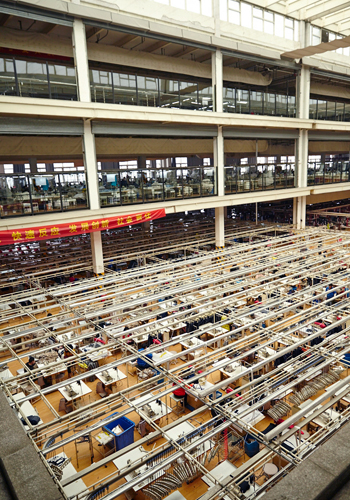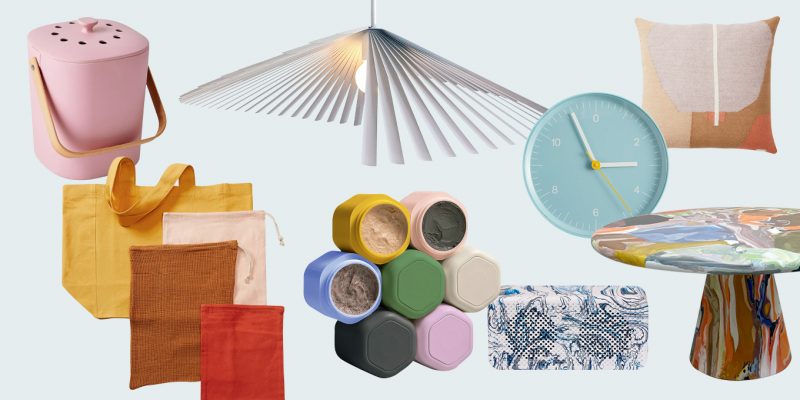Travel
ELLE WORLD: Fast fashion times
A 72-hour whirlwind behind-the-scenes tour into H&M’s fast fashion world – from the company's headquarters in Stockholm to a factory floor in China.
by : Christina Reynolds- Sep 4th, 2014

Hempel China Ltd., located in Hangzhou, is one of China’s largest garment factories and an H&M "preferred supplier." Photo by Philippe Roy
As I pack for a three-day trip to China, via Sweden, to visit one of H&M’s factories, I take stock of my closet. It’s filled with an eclectic mix of investment pieces, old favourites, sale finds—and a lot of “fast fashion.” According to market research firm TNS Global, 40 percent of our clothes comes from “value retailers.” But since the 2013 collapse of the Rana Plaza building in Bangladesh, where more than 1,100 factory workers were killed, many consumers—myself included—want to know more about the conditions under which these garments are made.
To learn more, ELLE Canada approached H&M—which did not make clothes at Rana Plaza but does produce more than 80 percent of its products at contracted factories in Asia—to see if we could get a first-hand look at where many of the clothes we’re wearing come from. The company readily agreed.
By the Numbers:
2.64 billion dollars: H&M revenue last year
116,000:
H&M employees worldwide
500,000: contracted factory employees worldwide who work for H&M as well as other retailers
1,946:
contracted factories worldwide that do work for H&M
FIRST STOP: H&M HEADQUARTERS IN STOCKHOLM
The head office, which is in the city’s trendy shopping district, is located in the same sleek building as a mega-flagship store (and across the street from another one). After being issued a security pass, I’m escorted to a conference room to talk with Henrik Lampa, the company’s
environmental-sustainability manager, and Helena Helmersson, global head of sustainability.
The first thing I ask Helmersson is whether she thinks the Accord on Fire and Building Safety in Bangladesh (which the company was first to sign on to) is making a difference. “The tragedy with Rana Plaza, even though we were not a buyer in there, was so huge,” she says. “Before that, we did a lot on fire safety, but obviously it wasn’t enough for the industry. We should have done more collaboration—and that is really what came with the accord, industry-wide,” she says, adding that the consortium of 170 brands and retailers aims to do 1,500 independent factory inspections in Bangladesh this year.
Helmersson, who worked in Bangladesh from 2006 to 2007 as an H&M human- resources manager, says the country is “close to her heart.” “Living in such a poor country was amazing but also very hard,” she says. “It makes you think ‘How can we do more?’” H&M has 20 of its own auditors conducting 500 or so inspections a year of the approximately 300 factories it works with in Bangladesh.
All of H&M’s supplier factories are inspected and scored using its Full Audit Program, which is based on the International Labour Organization’s conventions and the United Nations Declaration of the Rights of the Child. Every 18 to 24 months, auditors spend two to three days on-site at a factory to do a “full audit.” Using a list of about 200 questions, they look at everything from factory wages, overtime hours, workers’ ages and freedom of association to chemical handling and waste-water treatments.
They also conduct random worker interviews and review factory documents to make sure they are authentic. Each factory is then rated on a scale of 0 to 100 on the company’s Index Code of Conduct. In 2013, H&M’s average supplier was ranked at 77.8, up from 77.3 in 2012 and 76.5 in 2011.
At about six-month intervals between full audits, an H&M auditor visits for a day or so to see whether suppliers have made improvements. “We do these to coach suppliers in the right direction,” explains Helmersson. “After three follow-ups, we do a full audit again.”
The two key issues the auditors typically encounter—especially in Bangladesh—are overtime hours and waste-water treatment. “In China, waste water is on a good level, but we always have issues with workers’ rights to freedom of association,” says Helmersson. “We can’t work with unions to the same extent we can elsewhere, but we try to empower workers to do their own negotiations and have democratic elections in the factories.”
Three hours later—with many more topics still to explore—our chat is over and I am heading to the airport once again.
On the next page…the H&M headquarters in Shanghai and the Hempel factory in Xiaoshan…

A worker at one of the 3,500 sewing stations at the Hempel factory. Photo by Philippe Roy
SECOND STOP: H&M HEADQUARTERS IN SHANGHAI
Straight from the airport, we head to one of H&M’s two production offices in Shanghai. The workspace is packed with clothing samples hanging on long closet rails that sag under the weight. I’m brought to a meeting room for another three-hour chat, this time with Leyla Ertur, the country manager for production; Veronique Rochet, the regional sustainability manger; David Antonsson, the woven supply-chain manager; and Apple Cao, supply-chain sustainability manager for the woven-product group, among others.
Ertur tells me that the factory I will be visiting, which is owned and managed by Hempel China Ltd., was selected because it has earned H&M’s “gold” status, a designation for H&M’s “preferred suppliers.” While just 19 percent of H&M’s 872 suppliers have earned this ranking, they account for approximately 60 percent of production and average a score of 80.1 on the company’s Index Code of Conduct. H&M’s strategy is to reward partners who are willing to improve with additional orders and longer-term commitments.
“Not all the factories are like this,” Ertur goes on to explain. “This is one of the few factories where we have vertical production, so, from start to end, they do almost everything in-house, even the packaging. This is quite rare in China, but it will give us a chance to see different woven-product groups.”
By the numbers: Monthly wages
China: An H&M contracted factory worker in China’s Guangdong Province earns US$385 vs. the country’s minimum wage of US$183.
Bangladesh: An H&M contracted factory worker earns US$64 vs. the US$42 minimum wage in the country.
Cambodia: An H&M contracted factory worker earns US$99 vs. the national US$97 minimum wage.
THIRD STOP: THE HEMPEL FACTORY IN XIAOSHAN
The next day, we set out on a two-and-a-half-hour drive to the Xiaoshan district, in the city of Hangzhou, to visit the Hempel factory. The sun is trying to peek out, but the atmosphere is heavy and grey-brown. The Air Quality Index, a rating system used to determine contaminate levels, is over 201, which is considered “very unhealthy.” The highest level, 301 and above, is considered “hazardous.”
Shanghai-based Canadian photographer Philippe Roy, whom I’ve invited along for the day, tells me that he and his wife have three high-end air purifiers churning around the clock in their apartment and that there are days when they keep their young children home from school because the pollution level is too high for them to be outside.
H&M’s 2013 Conscious Actions Sustainability Report states that the highest percentage of greenhouse-gas emissions (36 percent) in its production chain is a result of fabric manufacturing. But because the company doesn’t have direct business relations at this stage of its production, it says it can’t place demands the way it can with its direct contract suppliers. That said, it is trying to “extend” its influence over fabric mills and gradually working to add them to its supplier-auditing program.
READ MORE: All our recent ELLE World stories
As we exit the freeway, we approach a brick building that looks more like a nicely landscaped shopping mall than a factory, each of its four levels featuring planter boxes with h roses. “I’ve never seen a factory quite like this, have you?” I ask Roy, who has photographed a number of industrial spaces in China. “Wow!” he says. “No, definitely not like this.” Located in the 218-hectare Hempel Fashion Industrial Park, this garment factory is one of China’s largest, with 3,500 sewing machines and a production capacity of 15 million garments a year.
Nancy Ko, the thirtysomething president and general manager of Hempel Fashion & Marketing Management, is waiting for us. She is also the daughter of factory owner Lit Kwan Cheung. We head to the boardroom, which is just down the hall from the factory floors.
Plates of beans, broccoli, scallops and pork have been brought over from the factory’s canteen, where the 4,000 workers eat. During lunch, I ask Cheung how her family got into the garment biz. She doesn’t speak English, but Ko, who spent two years of high school in Boston and studied business and marketing at the University of California, translates.
Cheung tells me that she and her late husband, Chiwei Ko, started out working in an embroidery factory, but they quit their jobs in 1992 to start Hempel’s first factory with a US$400,000 investment. Called Hangzhou Huili, it opened with only 80 sewing machines; its first order from H&M for 50,000 pieces came soon after. Three years later, the number of
sewing machines was up to 200. When I ask what it was first like to work with H&M and what challenges they’ve had, Cheung tells me about a difficult time in 1995, when they had “a very big quality issue that caused a lot of problems on the consumer side. We paid a lot of compensation,” she explains, referring to poorly sewn clothing.
But H&M didn’t drop the factory; instead, it brought in sewing trainers and taught Hempel staff how to improve their production. “This gave us a lot of confidence; it was a big turning point for us,” says Cheung. And H&M has continued the practice over the past two decades. “We’ve grown together, with good and bad days,” adds Ertur. “We still have good and bad with all of our supply chain. But H&M’s advantage has been that we have stayed committed to the market, and that has made a big difference. We’re not going to one country for a big discount one year and another the next—that has never been our strategy. I think that is why we have had such success in China.”
Cheung credits H&M with teaching them about human rights, social responsibility and industry trends. “We have learned a lot over the years, and it has helped us grow and expand,” she says. Ko, in particular, doesn’t just want more work from H&M; she wants to build a company like H&M—Hempel already produces three of its own in-house brands and has 200 stores across China.
On the next page…from the Hempel boardroom to the factory floor…

An H&M slip dress ready for inspection at the Hempel factory.
Photo by Christina Reynolds
NEXT UP: FROM BOARDROOM TO FACTORY FLOOR
The factory’s four floors are vast and filled with high-tech equipment, such as a computer-guided cutting bed and auto-mated hanging systems that move items from one production station to another. It’s bright—thanks to a gigantic overhead skylight—but also very chilly. It’s late winter and the air conditioning is off, but I’m told this is the normal temperature.
At ironing stations, workers are pressing men’s shirts at seemingly super-human speeds. We then walk into a section that has a sign saying “Special Lines for COS” (one of H&M’s other brands), where sewers are constructing a minimalist short-sleeved navy dress with black lace trim. This factory specializes in woven goods—dresses, skirts, blouses, jackets and, especially, outerwear. (If you have an H&M coat with a tag that says “Made in China,” there’s a good chance it was made here.)
A little farther over, I notice another sewing line where workers are sitting by bins marked “Qualified Goods” and “Callback Goods.” They are doing inspections and snipping threads from slip dresses made from the same silky h blue fabric and black lace as the COS dress—but this time with H&M labels attached.
This sharing of designs between brands is perhaps one little example of how the company keeps its costs (and prices) so low. Back in Stockholm, I’d asked Helmersson to talk about the common assumption that cheaper in-store prices equate with low wages and poor working conditions. She was adamant that this isn’t necessarily the case, especially for H&M. So I asked her to share some of the strategies that enable the company to keep its prices so competitive.
“I won’t give away all the biggest things to the competitors,” she said with a laugh. “I really think it is a mixture of the big volumes we have, the logistics and the mindset we have in our company, because ‘cost conscious’ is one of our seven values. So it is kind of built into our every day. You know, we do not take taxis; we take the bus instead.”
By the numbers: Hempel Factory
4,000:
workers
50/50:
ratio of female to
male workers
26
: average age
of workers
3,500:
sewing machines
15 million:
garments produced each year for H&M,
Zara, Walmart, Esprit,
Liz Claiborne, Gap,
Uniqlo, DKNY, BCBG, Donna Karan and
Giorgio Armani
50%:
More than half
of the work done at this factory is for H&M Hennes Mauritz brands.
Label makers: H&M Hennes Mauritz’s brands include not only
H&M but also COS, & Other Stories, Cheap Monday, Weekday and Monki.
I want to speak with some workers, so Apple Cao, who has been with the company for 10 years and whose team is responsible for this factory, offers to translate for me. Chen Fang, a 28-year-old who has worked here for four years as a sewer, tells me that she produces more than 300 collars a day and regularly works from 8 a.m. to 9 p.m. every day except Sunday. “I am very interested in the challenge of this job, and I can do other procedures too—if I have time, I can help others,” she explains. “I am happy working here and make friends here.”
Three other workers tell me similar stories, including 31-year-old Bai Ji Hong, who has been employed here for five years and whose husband works at a nearby factory while their 10-year-old daughter lives with relatives. Both of the men I talk to—one works in ironing, the other is a Code of Conduct trainer—have been with the factory since it opened, more than 10 years ago. Their commitment to the company is a good sign, says Julia Bakutis, a member of H&M’s sustainability team. “The culture in China is that if workers are unhappy, they ‘vote with their feet,’” she says.
H&M has a Code of Conduct that every supplier must sign. It includes policies on things like working hours, workers’ rights to unionize and minimum wages. But sometimes exceptions are made—for example, under Chinese law, only government employees can be unionized. Also, workers are typically paid by piece rate (which doesn’t incentivize employers to properly compensate for overtime hours), which is not H&M’s preference. “We have to work within each country’s system and try to change it as best we can,” explains Ertur.
When I ask about the long workday, Cao answers, “This is normal in China.” (The Fair Labor Organization reports that an estimated 50 percent of garment workers in China work more than 60 hours a week.)
In terms of wages, according to H&M’s most recent data from Hempel, the average monthly wage is CNY3800 to CNY3900, or US$622 to US$640. The minimum wage in this part of China is CNY1650 a month, or US$270. To put that in perspective, the average monthly wage for H&M workers in Bangladesh was US$64 in 2013, compared with the country’s average of US$42.
In November 2013, the company launched the Roadmap to a Fair Living Wage, a plan to help it empower factory workers to negotiate their own wages h and make sure its largest suppliers all pay a fair living wage by 2018. It’s based on a method developed by Daniel Vaughan-Whitehead, a labour economist and professor of corpor-ate social responsibility at Sciences Po in Paris. He is also the manager of wages and incomes policy at the International Labour Organization.
This year, H&M implemented a test version of the program in three model factories: two in Bangladesh and one in Cambodia. “For us to be able to hit fair living wages, we need to look at our own procedures and routines as a brand, like purchasing practices,” explains Helmersson. “But we also need to influence and incentivize suppliers and empower the workers.” So far in the test factories, the company reports that the workers and factory managers have begun to create new wage structures appropriate for each area and that the dialogue between these groups has improved.
On the next page…the Hempel staff dorms and H&M’s expansion plans…

Hempel’s staff dorm houses up to 6,000 people.
Photo by Philippe Roy
The final stop on my tour is the staff dorms, which are connected to the factory via a raised walkway. The 1,996 rooms, which house up to 6,000 staff, have bunk beds that sleep four and an alcove by the window for cooking. The rooms are clean but very small and quite dark. I can’t imagine living in a shared space like this for years. (Although the dorms do have private rooms for couples.)
Bakutis notices the uncertain expression on my face and quickly tries to assure me that these are some of the nicer dorms she has seen, adding that they’re above the local industry standard. But for employees like Fang (who has calculated that her walk from dorm to factory takes precisely six minutes), this factory/dorm/canteen is pretty much her whole world, except on Sundays. “That’s when I go out shopping with friends—with work colleagues,” she tells me with a big smile.
WHAT’S NEXT: H&M’S EXPANSION PLANS
H&M wants to raise more of its factories to Hempel’s overall “gold” level—while also adding significant production capacity that is needed to stock the 300 to 450 new stores it’s planning to add annually to its existing roster of 3,000. To expand production, H&M is now turning
to Africa—particularly
Ethiopia and Kenya, which do not have significant garment industries and can be difficult places to do business.
Achieving a living wage when, for example, the average salary in Addis Ababa is only US$30 a month, is a challenge. Back in Stockholm, I’d asked Helmersson about these plans. She emphasized that the expansion into Africa is not replacing any production currently being done in other parts of the world. “We want to make sure that our presence has a positive impact on these countries,” she said. “We’ve learned so much from being in Bangladesh and Cambodia—whether that’s chemical handling, wages, overtime or water treatment. We can demand a higher level from the beginning from our suppliers.”
BACK HOME
As I unpack my suitcase in Toronto, I’m still thinking about the complex challenges of producing vast amounts of low-cost clothing. There’s clearly a lot of effort being made to improve the process. As the world’s second-largest apparel company, with US$2.64 billion in annual revenue last year, H&M certainly has the finances and industry pull to bring about change. So let’s hold them accountable for all the promises—and all the potential.
READ MORE:
ONLINE EXTRA: Inside the design department at H&M headquarters in Stockholm. Plus: The company’s sustainability efforts with cotton and recycling.
ELLE WORLD: The Canadian-owned Pure Handknit garment factory in Thailand
ELLE WORLD: How Canadian-Ethiopian shoe company
Oliberté is taking on manufacturing in Africa
Newsletter
Join our mailing list for the latest and biggest in fashion trends, beauty, culture and celebrity.
Read Next

Fashion
Reitmans and The Birds Papaya Just Dropped The Dreamiest Spring Collection
Welcome to Sarah's Playhouse.
by : Melissa Fejtek- Apr 22nd, 2024

Decor
11 Zero Waste Decor Picks To Elevate Your Living Space
These brands are transforming waste materials into stylish products for your home.
by : Maca Atencio- Apr 22nd, 2024

Beauty
Tested and Approved: A Skin Saviour That Works While You Sleep
Wake up with your glowiest skin yet—even if you didn’t clock eight hours.
by : ELLE Canada- Apr 11th, 2024




